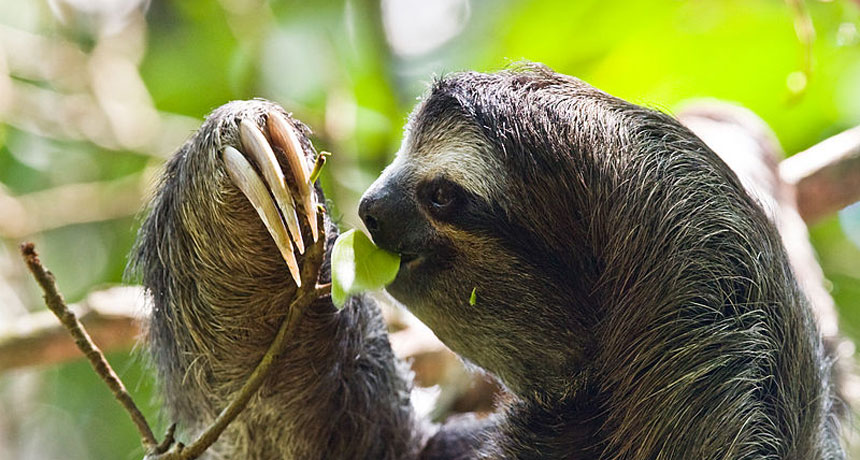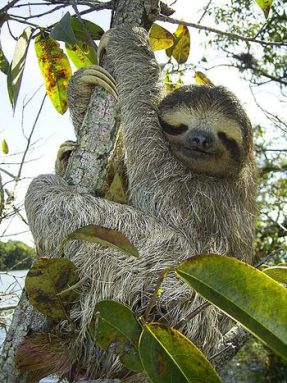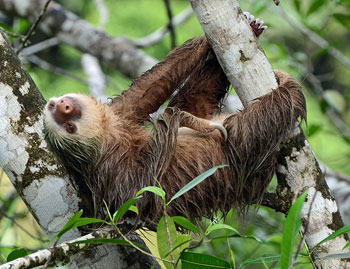This mammal has the world’s slowest metabolism
Three-toed sloths compensate by moving little and using the environment for heat

The brown-throated sloth is a type of three-toed sloth. It has the lowest rate of daily energy use of any mammal, a new study finds.
Christian Mehlführer, User:Chmehl/Wikimedia Commons (CC-BY 2.5)
There are degrees of slothfulness, even when it comes to sloths. And three-toed sloths may be the most slothful of all, new data show.
Researchers studied two species of sloth in Costa Rica. They measured the rate at which these animals’ bodies operate, converting food to fuel and growth. And this metabolic rate in one species of three-toed sloth was the lowest ever recorded — not just for a sloth, but for any mammal.
Six species make up the category of animals that most people call sloths. All fall into one of two families — either the two-toed or three-toed sloths. Both families live in trees throughout Central and South America where they eat leaves. But millions of years of evolution separate the families. Three-toed sloths tend to have smaller ranges and eat a more restricted diet than do their two-toed cousins. That means they prefer to dine on fewer species of trees. And they’ll usually eat from only a few individual trees.

Studies had shown that three-toed sloths have a very slow metabolic rate. But how slow? To find out, Pauli and his colleagues captured 10 brown-throated sloths. They are a three-toed species. The scientists also collected 12 Hoffmann’s sloths, which are a two-toed type. All came from a study site in northeastern Costa Rica. Here, the sloths live among a variety of habitats. These range from pristine forest and cacao (Ka-KOW) agroforest to fields of banana and pineapple.
“It’s really a quilt of different habitat types,” Pauli says. And it’s one that allowed the researchers not only to study many habitats at once but also to more easily capture and track sloths than if they were in dense jungle.
Many elements come in more than one form, or isotope (EYE-so-toap). The researchers injected the sloths with water labeled with specific isotopes of oxygen and hydrogen, then released the animals back to the wild. After 7 to 10 days, the scientists again captured the sloths and sampled their blood. By seeing how much of the isotope labels remained, they could calculate the sloths’ field metabolic rate. This is the energy that an organism uses throughout the day.
The field metabolic rate for the three-toed sloths was 31 percent lower than that for two-toed sloths. It also was lower than that found in any mammal that was not hibernating. The researchers reported this May 25 in the American Naturalist.

But there’s more to it than that, Pauli observes. “Three-toed sloths have the capacity to fluctuate their body temperature,” he points out. People need to keep their temperature within a few degrees of normal to stay healthy. But not sloths. They can let theirs rise and fall with the outdoor temperature. This is a bit like how a lizard or snake might regulate its body temperature. “Those are big cost savings to let your body change with your surroundings.”
Arboreal folivores (AR-bo-REE-ul FO-li-vors) are vertebrates that live in trees and eat only leaves. The new data help to explain why there aren’t more types of sloths and other arboreal folivores, Pauli and his colleagues argue. More than one-third of Earth’s land is forested. That means there is lots of treetop space for these critters. Yet few vertebrate species choose to subsist on tree leaves. In contrast, other types of animals have heavily diversified throughout habitats that take up much less space globally. For instance, there are 15 species of finch on just the Galapagos Islands. And there are hundreds of species of cichlid fish in Africa.
But there are constraints on being a leaf eater that lives in a tree. Leaf eaters tend to be big. The elephant and giraffe are good examples. They need a body big enough to accommodate a large digestive system that can process all of the leaf matter they need to survive. But an animal that lives in the trees can’t be too big. It needs lots of special adaptations for an arboreal life. And that might prevent the rapid diversification seen among other groups, such as Darwin’s finches, Pauli says.
Indeed, this might be why arboreal folivory is one of the world’s rarest lifestyles, says Pauli. It “is really tough living.”







